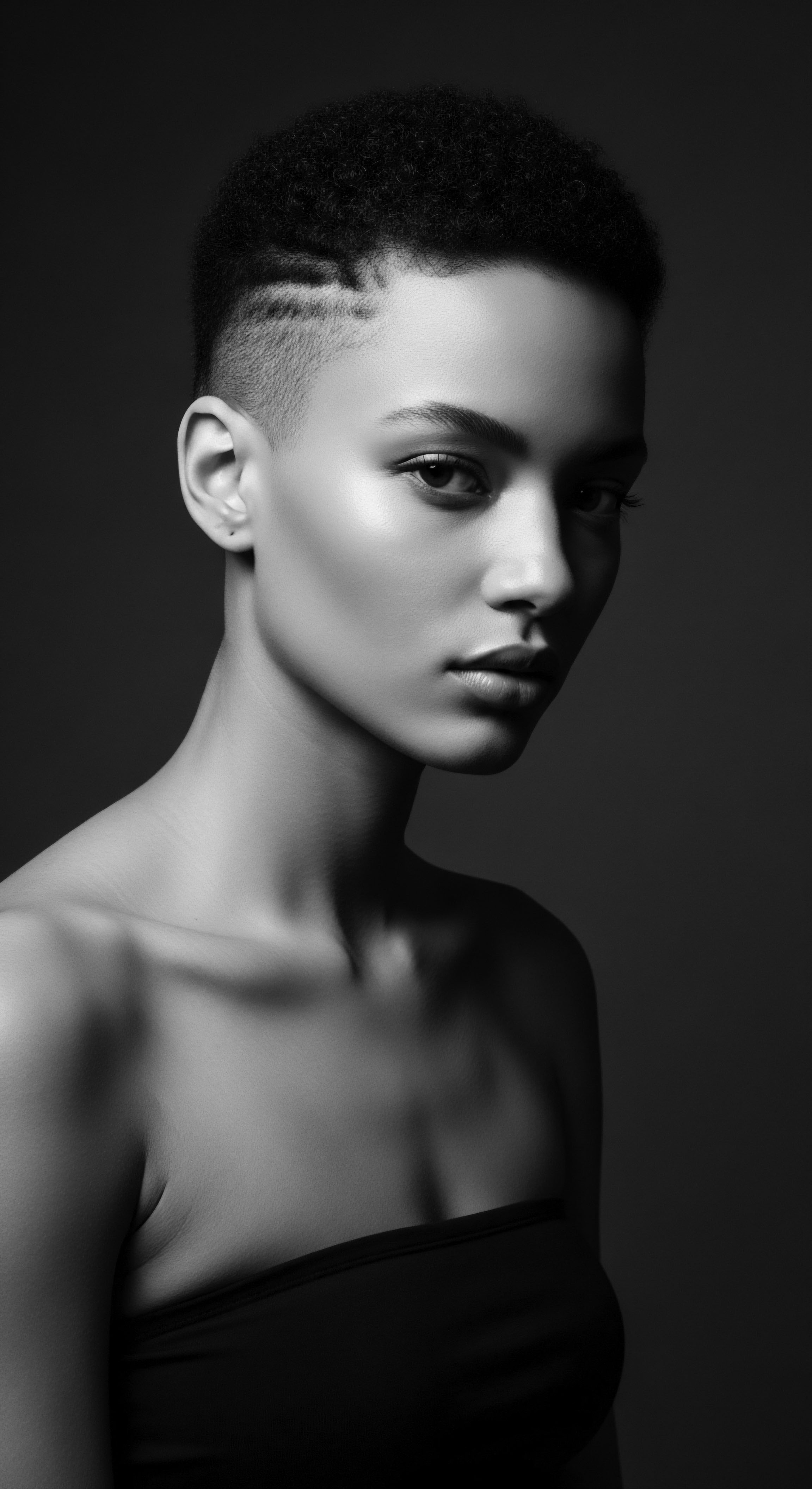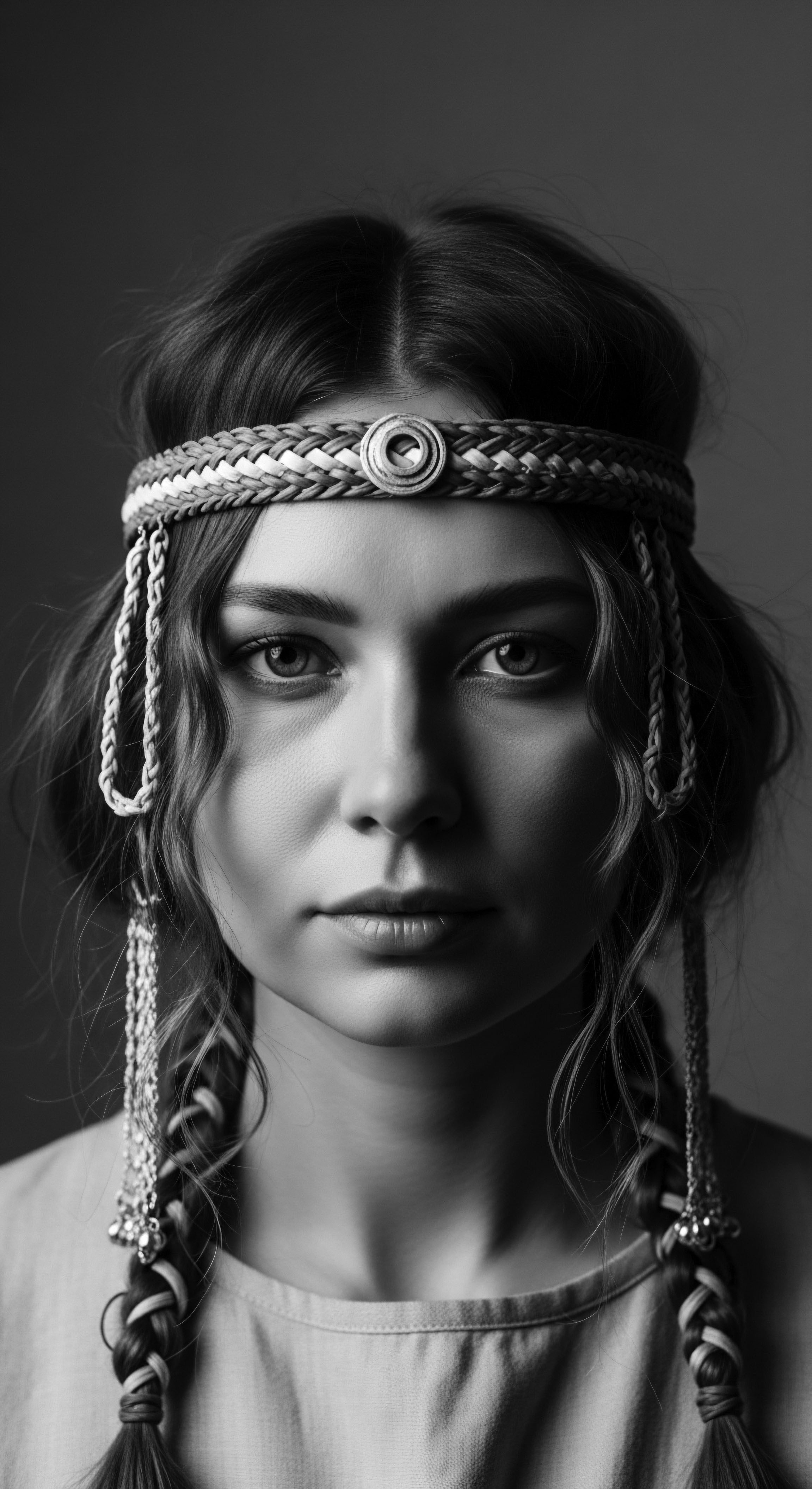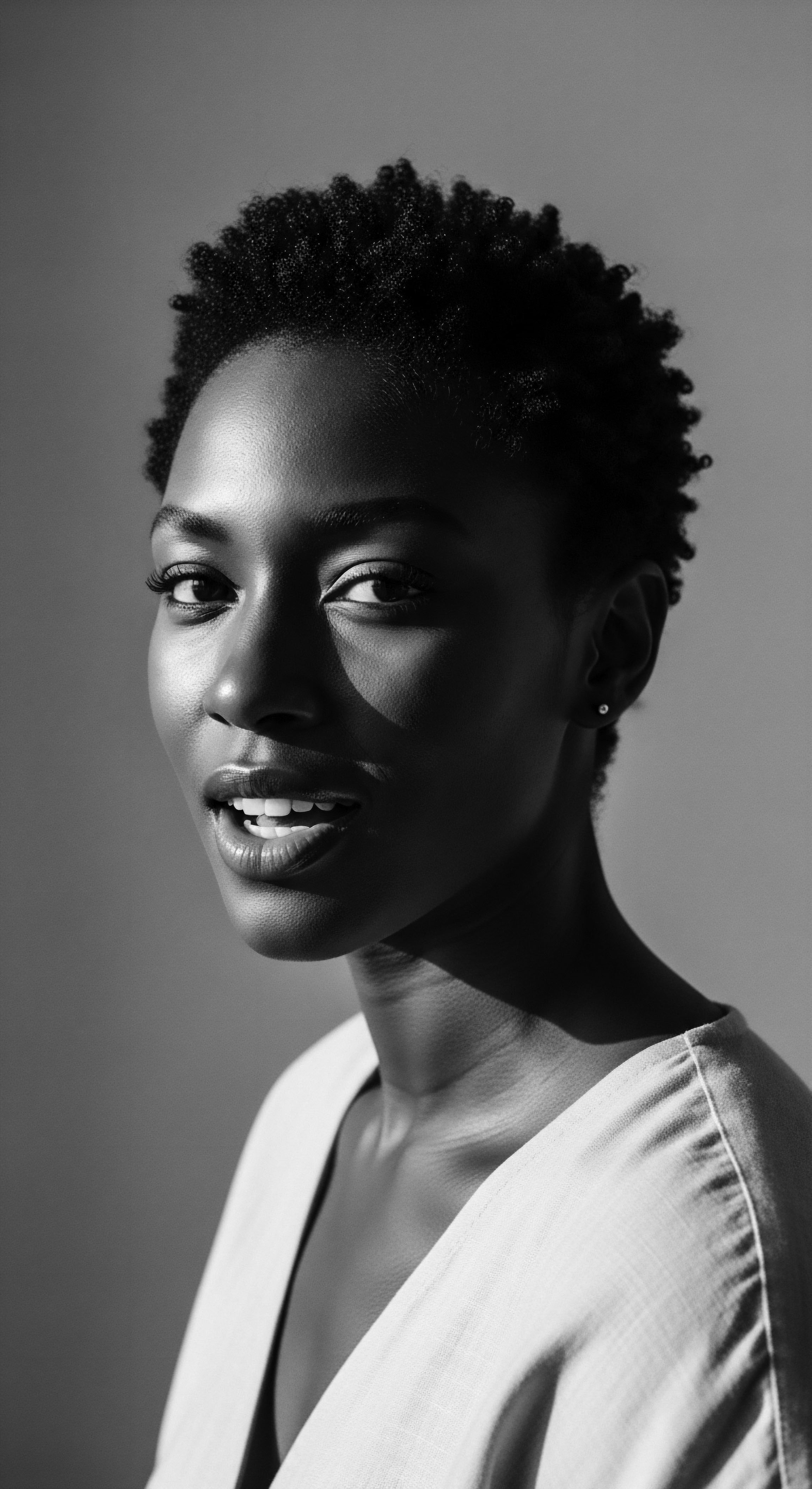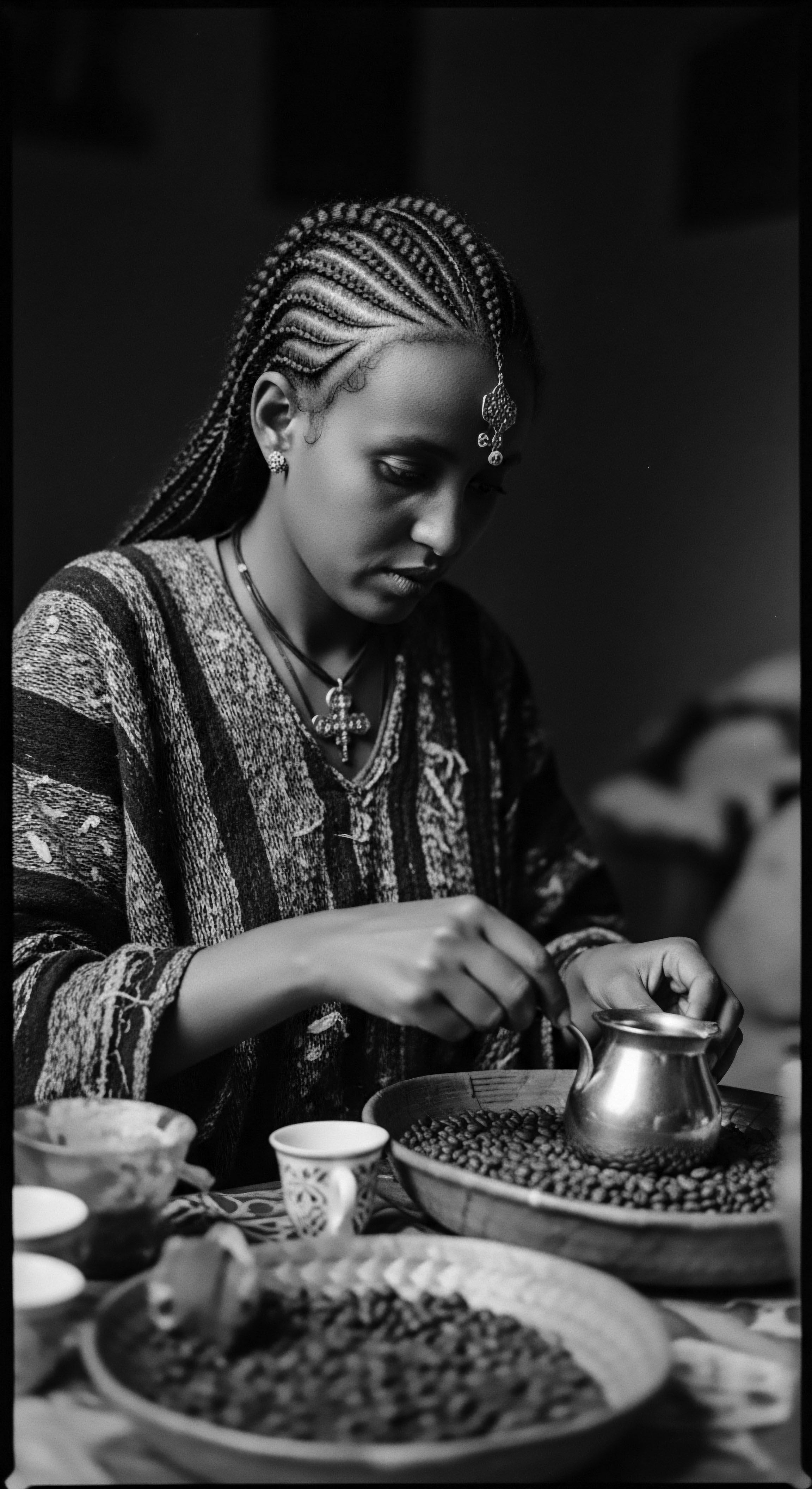
Roots
There exists within each curl, each coil, each textured strand, a vibrant memory, a whisper from ancient times. It speaks not of a mere aesthetic, but of a sacred trust, a lineage extending back through generations, across continents, into the very earth. For those whose hair bears the rich, varied textures of African and diasporic heritage, this isn’t simply a matter of biology. It is a living archive, a continuous conversation with ancestors, a testament to resilience.
Can the deep rhythms of these ancestral hair rituals, then, still offer solace and guidance in our contemporary pursuit of hair wellness? This inquiry invites us to trace a path through time, examining how the earliest understandings of hair, its structure, and its vitality were intertwined with cultural practice and communal identity. It suggests that modern textured hair care, when truly understood, is not a radical departure, but often a rediscovery, a harmonious echo of wisdom long held.

The Anatomy of Ancestral Strands
To truly grasp the continuum from ancestral practices to modern wellness, one must first look within the very structure of textured hair. Unlike its straighter counterparts, textured hair, whether spiraled, coiled, or kinked, emerges from a uniquely shaped follicle—often elliptical or ribbon-like—that dictates its characteristic curves and twists. This shape, combined with the way keratin proteins assemble, creates distinct points along the hair shaft where it can be more fragile, more susceptible to breakage if not handled with immense care.
Early communities, without microscopes or biochemical assays, understood this inherent delicacy through generations of lived experience and keen observation. Their practices, from gentle detangling to protective styling, implicitly recognized the need to fortify these vulnerable points, safeguarding the strand’s integrity.
The journey of a textured hair strand, from its birth within the scalp to its eventual release, is a cycle of growth and rest influenced by myriad factors. Ancestral communities, often living in close concert with their environment, observed how climate, diet, and even emotional states impacted hair vitality. A harsh dry season might have prompted deeper conditioning rituals with plant-based butters and oils. Times of stress or scarcity could visibly alter hair’s luster.
These observations were not abstract scientific data; they were tangible prompts for action, guiding the selection of ingredients and the timing of rituals. The traditional understanding of hair’s needs was deeply holistic, viewing the strand as an extension of the entire being, inseparable from internal balance and external conditions.

Hair’s Elemental Biology And Its Cultural Reflection?
The very biology of textured hair, with its unique cuticle patterns and propensity for dryness, profoundly influenced ancient care methods. The outer layer of the hair, the cuticle, acts as a protective shield. In textured hair, these cuticles often stand proud, creating micro-gaps that allow moisture to escape more readily. This inherent predisposition to dryness, recognized implicitly by forebears, led to a pervasive use of emollient ingredients and meticulous sealing practices.
Traditional African cultures, for example, consistently incorporated substances rich in fatty acids and vitamins. Shea Butter (Vitellaria paradoxa), often harvested and processed communally, served as a foundational moisturizer, its occlusive properties helping to retain water within the hair shaft. Similarly, various botanical oils, such as Palm Oil or Moringa Oil, were applied to condition and lubricate the hair, reducing friction and breakage.
These practices were not simply cosmetic. They were acts of preservation, wisdom passed down through touch and oral instruction. The very language used to describe hair, too, held cultural weight. In many West African languages, terms for hair were not merely descriptive of texture, but also of health, vitality, and even social status.
The concept of “good” hair was not necessarily tied to straightness, but often to its strength, its ability to hold intricate styles, and its overall healthy appearance—a visible sign of diligent care and well-being. This perspective offers a profound contrast to later colonial influences that sought to redefine beauty standards, demonstrating an original, authentic appreciation for textured hair in its natural state.
Traditional hair practices reveal an implicit, ancient understanding of textured hair’s unique biological needs, predating modern scientific explanation.
The taxonomic drive to classify textured hair types, a modern phenomenon, has roots, perhaps unintended, in ancient observations of diversity. While contemporary systems like the Andre Walker typing chart attempt to categorize curls by pattern, ancestral communities recognized variations in hair texture through practical engagement. They knew that certain hair types would respond better to particular styling methods or ingredients. This recognition wasn’t for marketing; it was for practical, effective care within families and communities, ensuring that each individual’s hair received tailored attention.
The nomenclature, while not formalized as a numerical system, existed in the shared knowledge of elders and practitioners, identifying hair by its feel, its response to moisture, and its styling potential. This communal knowledge was a living classification system, transmitted through the hands that braided and oiled, the voices that instructed.
| Traditional Practice Regular application of plant butters (e.g. shea, cocoa) |
| Underlying Ancestral Understanding Hair requires 'food' and a 'seal' to remain soft and strong. |
| Modern Scientific Corroboration Emollients and occlusives create a hydrophobic barrier, reducing transepidermal water loss from the hair shaft. |
| Traditional Practice Protective styles (braids, twists, locs) worn for weeks/months |
| Underlying Ancestral Understanding Hair needs rest from manipulation and exposure to the elements. |
| Modern Scientific Corroboration Reduces physical stress on the hair cuticle and shaft, prevents environmental damage (UV, pollution), and minimizes tangling. |
| Traditional Practice Communal detangling sessions with fingers and wide tools |
| Underlying Ancestral Understanding Gentle handling preserves hair length and prevents breakage. |
| Modern Scientific Corroboration Minimizes mechanical damage to the hair cuticle, preserving structural integrity and reducing frizz and split ends. |
| Traditional Practice The enduring efficacy of traditional textured hair care stems from an intuitive alignment with fundamental hair biology. |

Ritual
From the foundational understanding of the strand, we move to the living cadence of care itself—the rituals that transformed mere grooming into acts of cultural expression, communal bonding, and spiritual reverence. Can these time-honored rituals, brimming with symbolic meaning and practical wisdom, truly inform the regimen of modern textured hair wellness? To consider this, we must look beyond the simple act of applying a product and perceive the deeper purpose, the communal spirit, and the artistic expression embedded within these practices. The art and science of textured hair styling, particularly in Black and mixed-race heritage, has always been a dialogue between technique and identity, passed down like precious heirlooms.

The Protective Veil of Styling
Protective styling, a practice ubiquitous in textured hair communities today, finds its deepest roots in antiquity. Ancient Egyptian wall carvings depict elaborate braided and twisted styles, signifying status and devotion. Across various African kingdoms, styles like Cornrows (a term with historical baggage, but describing a technique seen across millennia) or intricate Bantu knots served not only as adornment but also as practical methods for preserving hair length and minimizing damage from daily life.
These styles shielded the hair from environmental harshness, reduced manipulative stress, and allowed for extended periods of growth. In essence, they were early forms of hair ‘conservation,’ a testament to foresight and ingenuity.
The construction of these styles was often a communal affair, particularly for women. Sitting for hours to have hair braided or twisted was not simply about getting a hairstyle; it was a time for storytelling, for sharing wisdom, for teaching younger generations, and for reinforcing familial and societal bonds. This collective engagement injected each braid, each twist, with shared meaning, transforming a personal adornment into a public declaration of identity and belonging. The ritual of collective styling, then, provides a blueprint for modern wellness that extends beyond individual product application, urging us to consider the social and emotional dimensions of hair care.

How Did Ancestral Styling Practices Convey Meaning?
The styles themselves often conveyed intricate messages—a lexicon written in hair. In some West African societies, specific braid patterns could signify marital status, age, tribal affiliation, or even periods of mourning. The direction of braids could indicate a journey, or the number of sections could symbolize family lineage. This depth of meaning meant that styling was a deliberate, mindful act, steeped in cultural protocols and inherited wisdom.
The hands that braided were not merely shaping hair; they were participating in a cultural dialogue, perpetuating a visual history. This rich heritage offers a powerful counter-narrative to beauty standards that devalue textured hair, grounding its value in deep historical significance rather than fleeting trends.
Traditional hair styling was often a profound language, conveying social status, identity, and historical narratives through intricate patterns and forms.
The tools employed in these ancient rituals were often simple, yet perfectly suited to the task. Fine-toothed combs crafted from wood or bone, picks designed to lift and section, and sharpened sticks for precise parting were extensions of the hands. These instruments, unlike some modern tools that inflict heat or chemical stress, honored the hair’s integrity, working in harmony with its natural patterns.
The rhythmic motion of hands and tools, the gentle tension, the patient unraveling of knots—all these aspects contributed to a mindful practice, a stark contrast to the often rushed, aggressive handling that can characterize contemporary hair routines. Reclaiming this gentleness, this deliberate approach to manipulation, is a valuable lesson from ancestral practices.
- Combs ❉ Hand-carved from wood, bone, or horn, designed with wide teeth to gently detangle and section hair without causing breakage.
- Picks ❉ Utilized for lifting hair from the roots, creating volume, or sectioning intricate patterns, preserving the hair’s natural curl pattern.
- Hair Adornments ❉ Beads, cowrie shells, gold, and other precious materials incorporated into styles to signify status, wealth, spiritual beliefs, or ceremonial occasions.

The Living Traditions of Natural Definition
Beyond protective styles, the enhancement of hair’s natural coil and curl also has ancestral precedents. Before the advent of chemical relaxers, communities honored the hair’s inherent texture, finding ways to define and maintain its natural splendor. Techniques involved not just specific applications of oils and butters, but also careful manipulation to encourage pattern definition.
Simple twists, coils, and finger manipulations, often sealed with botanical ingredients, helped to clump strands together, minimizing frizz and maximizing the visibility of the natural curl pattern. This appreciation for the hair’s intrinsic structure reflects a philosophy of working with the hair, rather than against it, a cornerstone of modern natural hair movements.
The historical use of natural ingredients for conditioning and styling is particularly telling. Consider the Red Palm Oil (Elaeis guineensis) used by various West African peoples. Beyond its nutritional value, its deep hue and conditioning properties made it a cherished hair treatment, providing shine and softness. Indigenous communities also utilized clays, plant extracts, and even certain plant fibers for cleansing and conditioning, understanding their properties through generations of trial and observation.
These ingredients were not manufactured in laboratories; they were gifts from the earth, their potency respected and their application ritualized. Their integration into hair care was a testament to humanity’s close relationship with the natural world and a profound understanding of botanical science long before formal chemistry.
The practice of adorning hair, too, held deep cultural resonance. Beads, cowrie shells, coins, and intricate thread work were woven into braids and locs, transforming hair into a living sculpture. These adornments could represent stories, ancestral journeys, or personal milestones. For instance, the Mbalantu women of Namibia are known for their incredibly long, thick locs, which they create and maintain using a paste of ground bark, oils, and butter, adorning them with intricate extensions and ornaments—a lifelong ritual of beauty and cultural identification.
(Van der Wouden, 2017, p. 74). This practice illustrates how hair care transcends mere hygiene, becoming an ongoing artistic and cultural endeavor, a visual declaration of belonging and identity.

Relay
As we trace the lineage of textured hair care, we arrive at the present, where the whispers of ancient rituals meet the roar of contemporary discourse. Can the enduring wisdom held within traditional cultural rituals truly guide modern textured hair wellness, particularly as identity and technology intersect? The answer lies in discerning how ancestral knowledge can inform and temper our scientific understanding, providing a compass for ethical engagement with hair, ourselves, and our collective past. This final exploration considers hair as a voice—a voice of identity, resilience, and an unbound potential shaped by heritage.

Modern Science Verifies Ancient Wisdom
The scientific lens, when applied with reverence, often validates the efficacy of traditional practices. Consider the widespread use of natural oils. Modern trichology confirms that oils such as jojoba or argan, similar in composition to traditional botanical extracts, can mimic the scalp’s natural sebum, offering protection and lubrication to the hair shaft.
The very act of cleansing with plant-derived saponins, practiced for millennia, aligns with modern gentle cleansing principles that prioritize preserving the hair’s natural moisture barrier. These correlations underscore a crucial point ❉ ancestral care was not based on superstition, but on profound, empirical observation and intuitive understanding of hair biology over centuries.
The structured layering of ingredients in traditional regimens—first a cleanse, then a moisture application, followed by a sealing oil or butter—mirrors the logical sequence of a modern ‘LOC’ or ‘LCO’ method (Liquid, Oil, Cream). This sequential application ensures deep hydration is locked into the hair, a critical step for textured hair prone to dryness. The consistent reapplication of butters and oils, observed in many historical accounts, served as a form of intermittent conditioning, preventing the hair from becoming brittle—a practice echoed in today’s deep conditioning treatments and regular moisturizing routines. The resilience of these foundational care principles speaks to their inherent effectiveness, regardless of the era.
Modern scientific insights often echo the fundamental principles embedded in traditional textured hair care practices, confirming their enduring efficacy.

How Does Understanding Hair Structure Validate Historical Care?
Understanding the unique structural characteristics of textured hair—its elliptical cross-section, its irregular cuticle layering, and its curl patterns that create points of weakness—provides a scientific underpinning for the traditional emphasis on gentle handling. The careful finger-detangling, the avoidance of harsh brushes, and the long-term commitment to protective styles were not just aesthetic choices. They were highly effective strategies for preserving the hair’s integrity at its most vulnerable points, minimizing mechanical stress that leads to breakage.
Today, scientific imaging reveals the micro-fractures that aggressive manipulation can cause, reaffirming the ancestral wisdom of tender touch as paramount to length retention and healthy hair growth. This scientific validation reinforces the need to approach textured hair with reverence, much as our ancestors did.
The concept of “feeding” the hair, a common metaphor in traditional African societies, aligns remarkably with modern nutritional trichology. Ancient peoples recognized that what went into the body influenced hair vitality. Diets rich in nutrient-dense plant foods, healthy fats, and protein, prevalent in many ancestral diets, provided the building blocks for strong hair growth.
While they might not have understood specific vitamins or amino acids, their dietary choices fostered an internal environment conducive to robust hair. This holistic perspective, linking internal wellness directly to external appearance, offers a timeless blueprint for true hair wellness—one that extends beyond topical applications to encompass systemic health.
- Internal Nourishment ❉ Ancestral diets rich in plant-based proteins, healthy fats, and minerals (e.g. from greens and tubers) directly supported hair follicle health.
- Scalp Massage ❉ Regular manual stimulation of the scalp, often with oils, encouraged blood circulation, providing nutrients to the hair bulb.
- Mindful Manipulation ❉ Gentle detangling with fingers or wide-tooth tools minimized breakage, preserving hair length and density over time.

Hair as an Unbound Helix of Identity
The journey of textured hair through history, particularly for Black and mixed-race communities, is a story intertwined with identity, resistance, and self-acceptance. During periods of enslavement and colonialism, efforts were often made to strip individuals of their cultural markers, including their hair. The forced adoption of Eurocentric hair standards was a tool of oppression, aiming to sever connections to heritage and instigate self-rejection. Despite these pressures, traditional practices persisted, often in secret, becoming powerful acts of defiance and quiet preservation of identity.
The cornrows that hid maps for escape, the communal braiding sessions that fostered solidarity—these were not merely hair treatments. They were acts of profound cultural and personal affirmation.
In the present era, the natural hair movement represents a profound reclamation of this heritage. It is a conscious decision to reject imposed standards and to honor the hair’s natural form, recognizing it as a direct link to ancestry and a powerful statement of self. The decision to wear one’s hair in its textured state, or to adopt styles rooted in ancestral practices, is a visual declaration of pride, a reconnection to a lineage of beauty and strength that colonialism sought to erase. This movement, therefore, is not merely a trend; it is a continuation of a historical struggle for bodily autonomy and cultural recognition, drawing deeply from the wellspring of ancestral resilience.
The rise of digital communities has further amplified this relay of ancestral wisdom. Platforms where individuals share styling tips, ingredient knowledge, and personal hair journeys echo the communal gathering spaces of old. While the physical proximity may differ, the spirit of shared learning and mutual support remains.
These digital forums become modern ‘villages’ where the knowledge of plant-based remedies, protective styling techniques, and holistic care principles, often passed down through generations, finds new expression and broader dissemination. This dynamic interplay between ancient knowledge and modern connectivity provides a powerful pathway for traditional cultural rituals to truly guide and shape contemporary textured hair wellness, ensuring the heritage remains vibrant and accessible.

Reflection
The enduring question of whether traditional cultural rituals can still guide modern textured hair wellness finds a resonant answer in the living history etched within each strand. We have walked through the elemental biology, understanding how ancient hands intuitively grasped the hair’s delicate nature, mirroring what microscopes show us today. We have witnessed the rituals, not just as acts of care, but as profound expressions of community, identity, and artistic narrative. And we have observed the relay, where ancestral resilience and wisdom continue to inform and fortify contemporary movements, bridging epochs through the power of shared knowledge.
Our textured hair, in its myriad forms, remains an unbound helix—a testament to journeys, struggles, and triumphs. It is a living, breathing archive of Black and mixed-race heritage. To care for it with intention, drawing from the deep well of ancestral practices and validating those insights with modern understanding, is to participate in a sacred dialogue. It is to acknowledge that the soul of a strand is not just in its present form, but in the echoes of every hand that has ever nurtured it, every story it has witnessed, and every future it continues to shape.

References
- Byrd, A. D. & Tharps, L. (2014). Hair Story ❉ Untangling the Roots of Black Hair in America. St. Martin’s Griffin.
- Hooks, b. (2014). Black Looks ❉ Race and Representation. Routledge.
- Mercer, K. (1994). Welcome to the Jungle ❉ New Positions in Black Cultural Studies. Routledge.
- Patton, T. O. (2006). Our Hair, Our Heritage ❉ The Cultural Significance of Hair in African and African American Cultures. Xlibris Corporation.
- Sieber, R. (1972). African Textiles and Decorative Arts. The Museum of Modern Art.
- Spillers, H. (2003). Black, White, and In Color ❉ Essays on American Literature and Culture. Duke University Press.
- Van der Wouden, A. (2017). African Hairstyles ❉ Styles of Yesterday and Today. NTV.
- Walker, A. (2002). Andre Talks Hair. Simon & Schuster.
- White, S. (2000). The African American Art of Hair. Chronicle Books.
